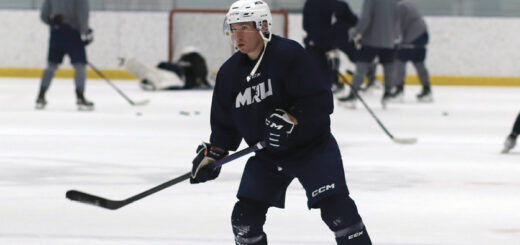Mining hockey silver down under

Photos courtesy of Tash Farrier Playing in front of a home crowd in her home country of Australia proved to be a special experience for Farrier.
By Blaine Meller
Sports Editor
If anyone doubts that hockey is quickly growing into a truly international game, talk to somebody in the know.
Somebody like Tash Farrier.
Farrier, 21, returned to Canada and her regular duties with the Cougars women’s hockey team after competing for her native Australia at the 2011 IIHF Women’s World Championships, Division 3, in Newcastle, Australia Feb. 1-6.
The host Australians lost to the Netherlands 3-2 in a shootout in the gold medal game, their best finish since claiming the championship in 2007.
This was the fourth world championship tournament for Farrier, who has also competed in IIHF events in South Africa, England and Finland. She was voted this year’s top forward after recording 11 points in five games, and also received the award in 2007.
“When you have the opportunity to represent your country, and play in your home country, whether it’s Division 3 hockey or any sport, you don’t really get that feeling anywhere else,” said Farrier.
Farrier admitted she nearly passed up this year’s tournament, largely because players are responsible for paying their own way. The expense of traveling to Australia, missing class and being away from her Cougars’ teammates were factors she looked at, but in the end, the allure of playing in a world championship in her home country was just too strong.
“I think the (gold medal) was the best game we’ve ever played. It was the biggest crowd we’ve had, because it was at home and was a once-in-a-lifetime opportunity,” she said.
The Australian national women’s team is an eclectic group, with players ranging in age from 16-38. Some of the players travel internationally to compete for the squad, including five from Canada.
Farrier’s hockey journey began at age 14, but she played an inline skate version of the sport when she was 10. From there, she traveled to Finland for a development camp and to see if hockey was something she wanted to pursue.
She was hooked.
Playing hockey in Australia, however, presented some challenges: Lack of players, a lack of depth, varying skill levels and a lack of coaching, training and development opportunities.
Farrier estimated that only about 60 players are competing on four women’s teams in the entire country, making it hard to grow the sport.
“Hockey in Australia is like cricket in Canada. It’s not that big at all. Our goal is to improve as a hockey team and increase participation in the sport, but it’s hard to get sponsorship. Sponsors want value for their investment, especially in media exposure, and we just don’t have that right now,” said Farrier.
“The people who support the game, those in the hockey community, are just so passionate about the game. Even though we don’t have the facilities or background in the game, hockey is their life.”
Going from the Canadian style of hockey, specifically that played by the Cougars, to the Australian game also presented some challenges.
“It’s a completely different game. Individually, I can go back (to Australia) to play and be so much better than I am here, but that is because of playing here,” said Farrier.
“There’s only so much you can do. In Australia, there are a few systems you play, but mostly I went out and just played hockey and kind of did what I want. Here in Canada, everyone is on the same level.”
The biggest challenge coming back from Australia and re-joining the Cougars last weekend against Red Deer was jet lag.
A 15-hour flight from Sydney to Los Angeles, a five-hour stopover, and then another flight to Salt Lake City before finally returning to Calgary took its toll on Farrier.
“I actually sat myself out in the third period against Red Deer. Mentally, I just could not get my body to work hard enough,” she said.



